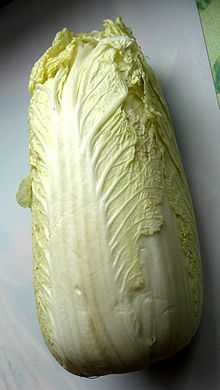Napa cabbage
| Napa cabbage | |
|---|---|
 | |
| Species | Brassica rapa |
| Cultivar group | Pekinensis Group |
| Origin | China, before the 15th century |
Napa or nappa cabbage (Brassica rapa subsp. pekinensis or Brassica rapa Pekinensis Group) is a type of Chinese cabbage originating near the Beijing region of China, and is widely used in East Asian cuisine. In much of the world, this is the vegetable referred to as "Chinese cabbage". It is also known as sui choi in Chinese and the West. In English, it is also called celery cabbage; in New Zealand, the name wong bok or won bok is used; while wombok is used in Australia. In the United Kingdom it is called Chinese leaf. Nappa cabbage is lighter in color than other Chinese cabbages such as bok choy, which is also sometimes called Chinese cabbage.
Naming
| Napa cabbage | |||||||||||||||||||
|
Some nappa cabbages | |||||||||||||||||||
| Chinese name | |||||||||||||||||||
|---|---|---|---|---|---|---|---|---|---|---|---|---|---|---|---|---|---|---|---|
| Traditional Chinese | 大白菜 | ||||||||||||||||||
| Simplified Chinese | 大白菜 | ||||||||||||||||||
| |||||||||||||||||||
| Cantonese | |||||||||||||||||||
| Chinese | 黃芽白 | ||||||||||||||||||
| |||||||||||||||||||
| Korean name | |||||||||||||||||||
| Hangul | 배추 | ||||||||||||||||||
| |||||||||||||||||||
| Japanese name | |||||||||||||||||||
| Kanji | 白菜 | ||||||||||||||||||
| Hiragana | はくさい | ||||||||||||||||||
| |||||||||||||||||||
The name "nappa" comes from colloquial and regional Japanese, where nappa (菜っ葉) refers to the leaves of any vegetable, especially when used as food.[1] The Japanese name for this specific variety of cabbage is hakusai (白菜), lit. "white vegetable", a Sino-Japanese reading of the Chinese name.
In much of the world, this is the vegetable referred to as "Chinese cabbage". It is also known as sui choy,[2] celery cabbage,[3] In the United Kingdom this vegetable is known as Chinese leaf, in New Zealand as wong bok or won bok, and in Australia and the Philippines as wombok.[4]
Vegetable
| Nutritional value per 100 g (3.5 oz) | |
|---|---|
| Energy | 68 kJ (16 kcal) |
|
3.2 g | |
| Dietary fiber | 1.2 g |
|
0.2 g | |
|
1.2 g | |
| Vitamins | |
| Vitamin C |
(33%) 27 mg |
| Trace metals | |
| Calcium |
(8%) 77 mg |
| Iron |
(2%) 0.31 mg |
| Magnesium |
(4%) 13 mg |
| Sodium |
(1%) 9 mg |
| |
|
Percentages are roughly approximated using US recommendations for adults. Source: USDA Nutrient Database | |
Napa cabbage is a cool season annual vegetable which grows best when the days are short and mild. The plant grows to oblong shaped head consisting of tightly arranged crinkly, thick, light-green leaves with white prominent veins. Innermost layer leaves feature light yellow color.[5]
Nappa cabbage is widely used in China, Japan, and Korea, where it is particularly popular in South Korea's northern Gangwon Province.[6] Nappa cabbage is used as a sign of prosperity in China,[7] and its image often appears as a symbol in glass and porcelain figures. The famous Jadeite Cabbage sculpture of Taiwan's National Palace Museum is a carving of a nappa cabbage variety. Because of immigrants from these nations, it is also readily found in many North American, European and Australian cities.
In Korean cuisine, sui choy is the main ingredient of baechu kimchi, the most common type of kimchi, but is also eaten raw as a wrap for pork or oysters, dipped in gochujang.[8] The outer, tougher leaves are used in soups. The flavor has been described by some as delicate compared to bok choy or cabbage, and it can be used in stir-fry with other ingredients such as tofu, mushroom or zucchini. It is also a very common ingredient that is eaten with hot pot.
References
| Wikimedia Commons has media related to Brassica rapa subsp. pekinensis. |
- ↑ "Oxford English Dictionary nappa, n.2". Retrieved 14 October 2010.
- ↑ "Chinese Cabbage". http://chinesefood.about.com/''. Retrieved 20 January 2015.
- ↑ "Chi′nese cab′bage". http://www.thefreedictionary.com''. Retrieved 20 January 2015.
- ↑ Afable, Patricia O. (2004). Japanese pioneers in the northern Philippine highlands: a centennial tribute, 1903-2003. Filipino-Japanese Foundation of Northern Luzon, Inc. p. 116. ISBN 978-971-92973-0-7.
- ↑ "Napa cabbage nutrition facts". http://www.nutrition-and-you.com/''. Retrieved 20 January 2015.
- ↑ Lee, Cecilia Hae-Jin (22 May 2012). Frommer's South Korea. John Wiley & Sons. p. 326. ISBN 978-1-118-33363-1.
- ↑ Klein, Donna (4 December 2012). The Chinese Vegan Kitchen: More Than 225 Meat-free, Egg-free, Dairy-free Dishes from the Culinary Regions of China. Penguin Group US. p. 30. ISBN 978-1-101-61361-0.
- ↑ Vongerichten, Marja (2 August 2011). The Kimchi Chronicles: Korean Cooking for an American Kitchen. Rodale. pp. 37–42. ISBN 978-1-60961-128-6.
